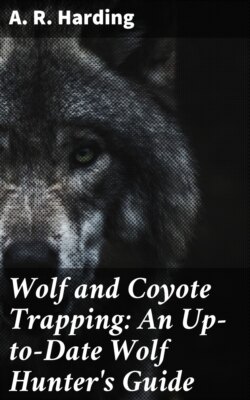Читать книгу Wolf and Coyote Trapping: An Up-to-Date Wolf Hunter's Guide - A. R. Harding - Страница 17
На сайте Литреса книга снята с продажи.
CHAPTER IV.
BOUNTIES.
ОглавлениеTable of Contents
For many years the state governments of the wolf infested country have been paying bounties on wolves and coyotes, to encourage the hunting and trapping of these animals. It is doubtful, however, whether the bounties offered are sufficient to encourage any, other than the regular trappers, to hunt wolves, and if they are, it has certainly had no definite results, for the wolves and coyotes, taken over the whole country, are practically as plentiful as ever.
Realizing that the state bounties were not a sufficient inducement to trappers, certain of the counties of those states where wolves are most abundant, offer additional bounty. This has the effect of thinning the wolves out of that county alone, but they immediately become more plentiful in the adjoining portions of the country.
In some of the Western States, the stockmen pay a bounty, in addition to that offered by the state. Some of them even offer special inducements, in addition to the bounties paid on the captured animals, and among them may be mentioned, board and lodging for the trapper, bait for the traps and the use of saddle and pack horses.
Such special offers to trappers have the effect of stimulating the hunting and trapping of noxious animals in that immediate vicinity and the result is, a thinning out of the animals for the time being. Usually the trappers drift into those sections where the animals are most plentiful and the bounty is highest.
One of the Government bulletins has the following to say regarding the bounty question:
"Bounties, even when excessively high, have proved ineffective in keeping down the wolves, and the more intelligent ranchmen are questioning whether the bounty system pays. In the past ten years Wyoming has paid out in State bounties over $65,000 on wolves alone, and $160,156 on wolves, coyotes and mountain lions together, and to this must be added still larger sums in local and county bounties on the same animals."
"In many cases three bounties are paid on each wolf. In the upper Green River Valley the local stockmen's association pays a bounty of $10 on each wolf pup, $20 on each grown dog wolf, and $40 on each bitch with pup. Fremont County adds $3 to each of these, and the State of Wyoming $3 more. Many of the large ranchers pay a private bounty of $10 to $20 in addition to the county and state bounty. Gov. Bryant B. Brooks, of Wyoming, paid six years ago, on his ranch in Natrona County, $10 each on 50 wolves in one year, and considered it a good investment, since it practically cleared his range of wolves for the time. It invariably happens, however, that when cleared out of one section the wolves are left undisturbed to breed in neighboring sections, and the depleted country is soon restocked."
"A floating class of hunters and trappers receive most of the bounty money and drift to the sections where the bounty is highest. If extermination is left to these men, it will be a long process. Even some of the small ranch owners support themselves in part from the wolf harvest, and it is not uncommon to hear men boast that they know the location of dens, but are leaving the young to grow up for higher bounty. The frauds, which have frequently wasted the funds appropriated for the destruction of noxious animals almost vitiate the wolf records of some of the States: If bounties resulted in the extermination of the wolves or in an important reduction in their number, the bounty system should be encouraged, but if it merely begets fraud and yields a perpetual harvest for the support of a floating class of citizens, other means should be adopted."
